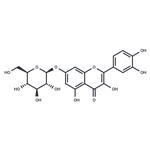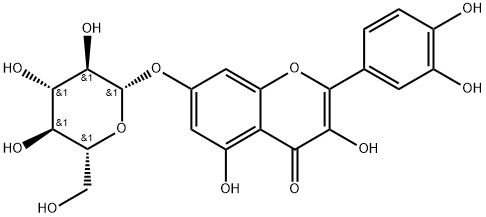- Quercimeritrin
-

- $39.00 / 1mg
-
2024-10-31
- CAS:491-50-9
- Min. Order:
- Purity: 98.84%
- Supply Ability: 10g
- C.I. 75710
-

- $3.00 / 1KG
-
2020-01-19
- CAS:491-50-9
- Min. Order: 1KG
- Purity: 98%
- Supply Ability: 1kg,5kg,50kg
|
| | Quercetin-7-O-β-D-glucopyranoside Basic information |
| Product Name: | Quercetin-7-O-β-D-glucopyranoside | | Synonyms: | C.I. 75710;7-(β-D-Glucopyranosyloxy)-2-(3,4-dihydroxyphenyl)-3,5-dihydroxy-4H-1-benzopyran-4-one;7-(β-D-Glucopyranosyloxy)-3,3',4',5-tetrahydroxyflavone;7-(β-D-Glucopyranosyloxy)-5,3',4'-trihydroxyflavonol;QuerciMeritroside;Quercetin-7-O-β-D-glucopyranoside;quercetin 7-O-beta-D-glucoside;4H-1-Benzopyran-4-one,2-(3,4-dihydroxyphenyl)-7-(b-D-glucopyranosyloxy)-3,5-dihydroxy- | | CAS: | 491-50-9 | | MF: | C21H20O12 | | MW: | 464.38 | | EINECS: | | | Product Categories: | chemical reagent;pharmaceutical intermediate;phytochemical;reference standards from Chinese medicinal herbs (TCM).;Flavanols;standardized herbal extract | | Mol File: | 491-50-9.mol |  |
| | Quercetin-7-O-β-D-glucopyranoside Chemical Properties |
| storage temp. | 2-8°C | | solubility | DMF: 10 mg/ml; DMSO: 10 mg/ml; PBS (pH 7.2): 0.3 mg/ml | | form | A crystalline solid | | Boiling point | 859.2±65.0 °C(Predicted) | | density | 1.809±0.06 g/cm3(Predicted) | | Melting point | 248 °C | | pKa | 5.92±0.40(Predicted) | | color | White to yellow | | LogP | -0.367 (est) |
| | Quercetin-7-O-β-D-glucopyranoside Usage And Synthesis |
| Occurrence | Quercimeritrin is a natural product found in Dendroviguiera sphaerocephala, Dendroviguiera eriophora, and other organisms with data available. | | Definition | ChEBI: Quercetin-7-O-β-D-glucopyranoside is a quercetin O-glucoside in which a glucosyl residue is attached at position 7 of quercetin via a beta-glycosidic linkage. It has a role as an antioxidant and a metabolite. It is a beta-D-glucoside, a monosaccharide derivative, a member of flavonols, a tetrahydroxyflavone and a quercetin O-glucoside. | | Antimicrobial activity | Quercetin-7-O-beta-D-glucopyranoside has antibacterial activity, it shows promising activity against Staphylococcus aureus. Quercetin 7-O-beta-D-glucopyranoside exhibits strong antioxidative, and anti-inflammatory activities, inhibiting expression of inducible nitric oxide synthase and release of nitric oxide by lipopolysaccharide-stimulated RAW 264.7 macrophages in a dose-dependent manner. It inhibits overexpression of cyclooxygenase-2 and granulocyte macrophage-colony-stimulating factor. | | Biological Activity | Quercetin-7-O-β-D-glucopyranoside is a flavonoid originally isolated from G. hirsutum that has diverse biological activities, including antioxidant, anti-inflammatory, and anti-angiogenic properties. It has antioxidant activity in a oxygen radical absorbance capacity (ORAC) assay and decreases tert-butyl hydroperoxide-induced reactive oxygen species (ROS) production in L-929 cells when used at concentrations of 0.25 and 1 μg/ml. Quercetin-7-O-β-D-glucopyranoside (15 and 30 μg/ml) reduces protein levels of inducible nitric oxide synthase (iNOS) and COX-2 in LPS-stimulated RAW 264.7 cells. It decreases angiogenesis in isolated rat aortic rings and proliferation of human umbilical vein endothelial cells (HUVECs) but has no effect on tube formation or chemotaxis of HUVECs when used at a concentration of 100 μM. |
| | Quercetin-7-O-β-D-glucopyranoside Preparation Products And Raw materials |
|